![]()
Vitamin D
...or how Shaun the Sheep helps prevent rickets!
![]()
Paul May
University of Bristol
![]()
Molecule of the Month - November 2015
(Updated Sept 2019)
Also available: JSMol version.
![]()

|
Vitamin D...or how Shaun the Sheep helps prevent rickets!
Paul May
Molecule of the Month - November 2015
|
 |
Well, actually, is a shorn sheep that can cure rickets, but we’ll come onto that in a minute.
Rickets is a childhood disease characterised by soft weak bones. As the child grows, becomes heavier, and then starts walking, the leg bones bend and bow under the weight, producing a characteristic bow-legged walk. Other bones, such as those in the arms and skull can also be affected, leading to disfigurement and disability. Until about 100 years ago rickets was quite common, even in in the US and Europe. Nowadays it is rare in most developed countries, although it can still occur in poorer countries.

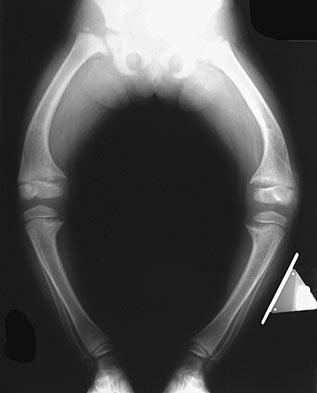
Left: A photo of a Victorian child with rickets. Right: An X-ray showing the characteristic bow-legs.
Scientists found out the cause of rickets, which turned out to be a deficiency of an essential molecule called vitamin D. Vitamin A (see MOTM Jan 2017) had already been discovered in 1914 as a component in cod liver oil, and when a British doctor called Edward Mellanby fed cod liver oil to young dogs, he noticed they did not develop rickets. At first he thought it was the vitamin A that was the active cure, but this was disproven when an American researcher called Elmer McCollum tested modified vitamin-A-free cod liver oil on dogs, and they too were cured. So some other substance in the cod liver oil was the true cure, and this unknown molecule was called vitamin D (as it was the fourth such vital nutrient to be discovered after vitamins A, B and C). This finding led to teaspoons of cod liver oil being given to children regularly until the 1980s, in an effort to provide them with the vital vitamin D.
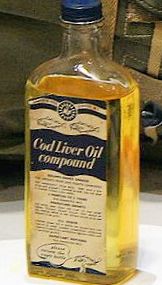
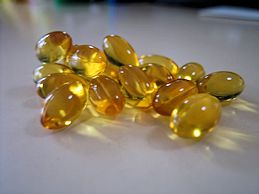
Left: Cod liver oil. Right: Cod liver oil gell pills
[Image:Adrian Wold - Woldo - Own work. Licensed under CC BY 2.5 via Wikimedia Commons]
Some people still do take it on a regular basis, but it was gradually realised that with a standard healthy western diet (often which contains vitamin D added by food manufacturers), and reasonable exposure to sunlight, a normal person should get all the vitamin D they require without having to eat any supplements. Having said that, there are some recent reports that say supplements might be needed in places where there is poor diet and/or little exposure to sunlight, especially over the long dark winter months. Indeed, since 2016 the UK government has recommended daily Vitamin D supplementation for everyone between October and March, as they say some people are not likely to get quite enough from fortified foods.
Although some foods contain vitamin D, such as mushrooms, fatty fish, egg yolk, and beef liver, the quantities aren’t that great, and up to 50% of the vitamin D can be destroyed by heating if the food is cooked. In fact, humans get most of their vitamin D by photosynthesis!
Photosynthesis just means synthesising something using light. Plants photosynthesise sugars from water and CO2 using sunlight. But humans photosynthesise vitamin D in their skin, when UV light interacts with 7-dehydrocholesterol which is produced naturally in the liver as a precursor to cholesterol.
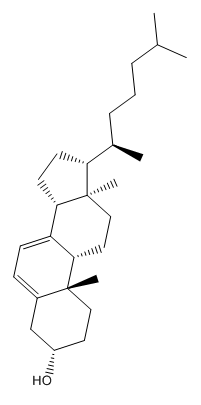
7-Dehydrocholesterol
(compare this the structure of cholesterol).
Yes, too much exposure to the UV in sunlight does cause skin cancer, but in contrast, not enough exposure is also a problem, because sunlight is required to make vitamin D in your skin. Indeed, with the increasing usage of high SPF sun-creams to block out harmful UV, the incidence of rickets in the western world is starting to slowly rise again. There were about 300 cases of rickets reported in the UK in 2014. As well as excessive sun-cream use, the recent rise in rickets has been blamed on children increasingly playing computer games inside rather than playing outdoors, and even on a spate of cloudy summers!
 So should we stop using sun-creams?
So should we stop using sun-creams?No, certainly not. Too much of good thing can be deadly. The trick is to get the balance right. Limited sunlight exposure is good, such as when the sun’s rays are less powerful (morning or evening), but continuous exposure to direct midday sun is dangerous. So you could say the question of how much sunlight to expose yourself to is a bit of a ‘D-lemma’! (get it?)
The presence of fur in animals or feathers in birds blocks UV light from reaching the skin. So in these cases, the creatures’ skin secrete oils or waxes which coat and impregnate its fur or feathers. Sunlight then interacts with the oil and produces vitamin D, which is then ingested by the animal or bird when it grooms itself.
Exactly, in the case of a sheep, the oil that’s secreted is called lanolin, and is the original source of much of the vitamin D found in food additives. The fleeces from shorn sheep are greasy to the touch, due to the lanolin, and this is washed off, and the lanolin purified and chemically treated to extract the vitamin D. The clean wool then goes on to make clothes, etc. The purified vitamin D, in the form of a white powder, is more expensive weight-for-weight than gold. It is added into various foods, such as bread or breakfast cereals, as a way to ensure we get sufficient vitamin D in our diets, even in the sunless winter months.
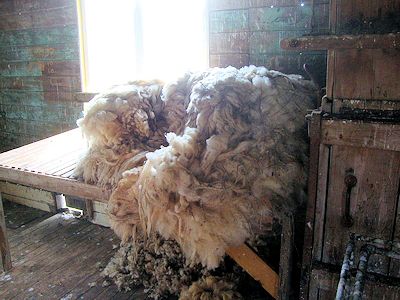
The fleeces from shorn sheep are full of lanolin.
[Image from: Schwede66 (Own work) [CC BY-SA 3.0], via Wikimedia Commons.]
Vitamin D does two main jobs in the body. First, it helps absorb calcium from foodstuff in the intestines, preventing it from being excreted from the body and lost. Calcium is vital for bone growth, so a lack of calcium means that bones do not grow properly or strong enough, leading to rickets or diseases like osteoporitis.
Its second job is to help dissolve away unwanted bone.
If there were only a mechanism to grow bone and not to remove it, bone would endlessly grow out of control and become too large. Bone has to be both deposited and then shaped by careful removal of the excess, in the same way a sculptor takes a large block of stone and removes the unnecessary parts.
Well, it’s actually not just one molecule, it’s 5 closely related molecules, called vitamins D1-D5. The two most important of these for humans are D3 (also called cholecalciferol) and D2 (ergocalciferol). Vitamin D1 isn't actually a single molecule, but a mixture of D2 and a closely related precursor molecule called lumisterol. When the term ‘Vitamin D’ is used without any subscripts (as is often the case on food packaging) it refers to either D2, D3 or to a mixture of both also known as calciferol.
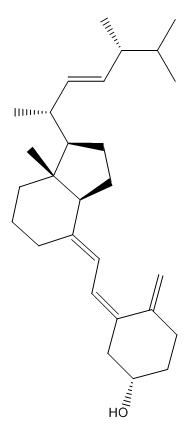 |
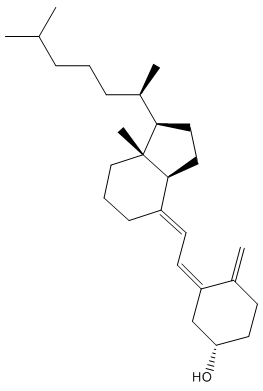 |
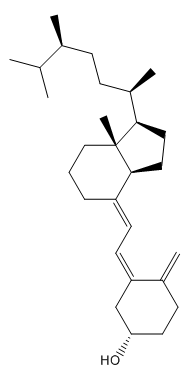 |
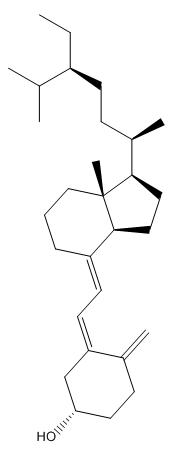 |
Vitamin D2 |
Vitamin D3 |
Vitamin D4 |
Vitamin D5 |
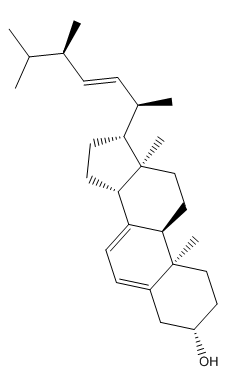 |
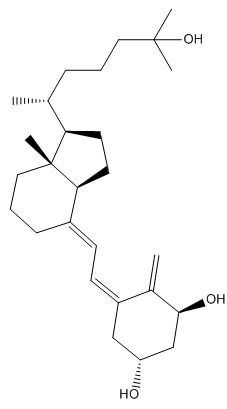 |
Lumisterol |
Calcitriol |
And in fact, these aren’t even the bioactive forms of the molecule. After being synthesised in the skin (or ingested), vitamins D2 and D3 are carried in the bloodstream to the liver, where enzymes convert them into calcidiol, and then to the kidneys, where different enzymes convert them into calcitriol. Calcitriol is the true bioactive molecule, and can be classed as a hormone, controlling the calcium concentration in the blood, which in turn, controls the growth and remodelling of bones. The three OH groups on the triol allow it to bond to a receptor (Vitamin D Receptor, VDR) molecule, which in turn triggers DNA to synthesise proteins that either make bone from calcium in the blood, or dissolve bone releasing Ca back into the blood.
Well, a study published in 2017 in the British Medical Journal says that vitamin D also plays a role in the immune system, which uses it to make antimicrobial molecules that attack bacteria and viruses. This may be why people living in the Northern hemisphere get so many colds and sniffles in the winter, when their levels of vitamin D are lower. The team at Queen Mary University in London looked at respiratory tract infections - such as a simple sniffle to flu and even pneumonia. They found that those people who took vitamin D supplements over the winter had far fewer repiratory infections than those that didn't. The study recommended that everyone should take vitamin D supplements, and claimed that if so, one person in every 33 would be spared these sorts of infections. However, the story is not clear cut...and Public Health England are being cagey about the findings, saying that the evidence on vitamin D and infection is inconsistent and that this study does not provide sufficient evidence to support recommending vitamin D for reducing the risk of respiratory tract infections. But watch this space...
During the COVID-19 outbreak in 2020 it was speculated that vitamin D helped reduced the severity of COVID symptoms, or even prevented someone from catching the virus at all. This idea was based on the observation that people with darker-coloured skin had a much higher mortality rate than those with a fairer skin colour; and that people with dark skin often have lower levels of vitamin D. However, although plausible, there is no evidence to back up this theory at the moment, but again, watch this space...

Shaun the Sheep in Bristol, July 2015.


![]() Back to Molecule of the Month page. [DOI:10.6084/m9.figshare.5259826]
Back to Molecule of the Month page. [DOI:10.6084/m9.figshare.5259826]